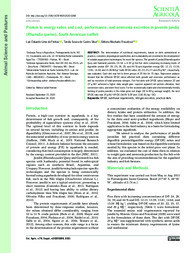Protein to energy ratios and cost, performance, and ammonia excretion in juvenile jundiá (Rhamdia quelen), South American catfish.
Protein to energy ratios and cost, performance, and ammonia excretion in juvenile jundiá (Rhamdia quelen), South American catfish.
Author(s): FREITAS, L. E. L. de; SILVA, T. S. de C.; FRACALOSSI, D. M.
Summary: The determination of nutritional requirements, based on diets administered in practice, considers physiological specificities and sustainability are essential to the development of suitable aquaculture technologies for novel fish species. The growth of jundiá (Rhamdia quelen Quoy and Gaimard) juveniles (31.54 ± 4.92 g) fed five diets comprising increasing levels of digestible protein (DP: 24, 29, 34, 39, and 44 %) and digestible energy (DE: 12.13, 13.39, 13.81, 14.64, and 15.06 MJ kg-1) with DP:DE ratios: 20, 22, 25, 27, and 29 g MJ k-1, respectively, was evaluated. Each diet was fed to three groups of 25 fish for 75 days. Regression analysis showed that the different DP:DE ratios affected both growth and economic performance as well as excretion of total ammonia nitrogen. Fish fed diets with DP:DE ratios between 22 and 27 g MJ k-1 achieved a higher daily weight gain, superior apparent net protein utilization, feed conversion rates, and lower feed costs. For the economically viable and environmentally friendly farming of jundiá juveniles in the initial grow-out stage (30 to 80 g average weight), the best DP:DE ratio was 25 g MJ K-1 DP:DE (34.05 % DP and 13.81 MJ kg-1 DE).
Publication year: 2021
Types of publication: Journal article
Keywords: Catfish, DP-DE, Excretion, Nitrogen, Nitrogênio, Nutritional adequacy, Nutrição Animal, Peixe, Rhamdia Quelen
Observation
Some of Embrapa's publications are published as ePub files. To read them, use or download one of the following free software options to your computer or mobile device. Android: Google Play Books; IOS: iBooks; Windows and Linux: Calibre.
Access other publications
Access the Agricultural Research Database (BDPA) to consult Embrapa's full library collection and records.
Visit Embrapa Bookstore to purchase books and other publications sold by Embrapa.

